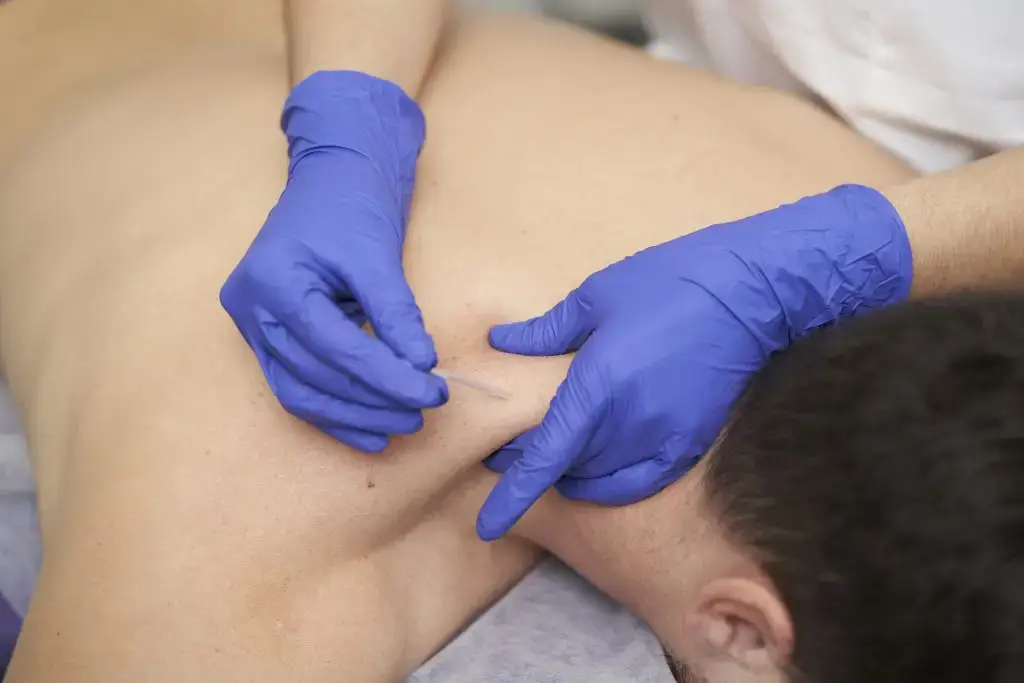Whether you’re dealing with muscle spasms or recovering from a sports injury, dry needling could be a helpful addition to your treatment plan with its evidence-based benefits for releasing muscle tension, promoting blood flow, and stimulating the body’s natural healing response. With roots in ancient practices and backed by a modern scientific approach, dry needling can be a helpful complement to a comprehensive physical therapy treatment plan for many injuries and conditions.
What is dry needling therapy?
Dry needling therapy is a targeted treatment aimed at alleviating muscle pain and improving function. It involves inserting thin needles into specific trigger points in the muscle tissue. These points are often areas of tenderness or “muscle knots” called myofascial trigger points, which can cause pain and discomfort.
The theory behind dry needling is that by targeting these trigger points, the therapy can help release muscle tension, improve blood flow, and promote healing. This is thought to result in pain relief and enhanced range of motion in the treated area. Unlike traditional treatments that may only address symptoms, dry needling aims to treat the root cause of muscular pain.
Origins of dry needling
Dry needling is a relatively modern adaptation of a technique that has been used for centuries. Originating from the ancient art of acupuncture, dry needling has evolved with a distinct focus on muscle pain and dysfunction. The method was first pioneered by Dr. Janet Travell in the mid-20th century, who used hypodermic needles to treat myofascial pain syndromes. Over the years, practitioners refined the technique, adopting fine filiform needles similar to those used in acupuncture, but with a distinctly different approach.
Today, dry needling is a widely accepted methodology used in physical therapy practices throughout the country, appreciated for its effectiveness in relieving pain and promoting healing without side effects or discomfort.
Dry needling vs. acupuncture
It’s important to distinguish between dry needling and acupuncture, as they serve different purposes despite some superficial similarities. While both practices use thin needles inserted carefully into the skin, their foundations and applications differ significantly.
Acupuncture is based on traditional Chinese medicine and focuses on restoring balance and energy flow within the body. It works on the principle of altering the qi (energy) flow along specific meridian points. Practitioners use acupuncture to treat a variety of ailments, from headaches to chronic diseases, by targeting energy pathways.
Dry needling, on the other hand, is rooted in modern Western medicine. It specifically targets musculoskeletal pain by addressing trigger points in the muscle tissue. The goal is to alleviate pain and improve function directly related to muscle tension and dysfunction. While both techniques involve the insertion of needles, acupuncture techniques don’t penetrate as deeply, which is why only certified physical therapists should attempt dry needling procedures.
Understanding these differences is crucial for anyone trying to choose between these similar treatments. If you’re seeking relief from muscle pain, dry needling might be the more appropriate choice, as it focuses specifically on releasing muscle tension and improving function. On the other hand, if you’re interested in a holistic approach to health, acupuncture might offer the broader benefits you’re looking for.
Conditions dry needling can treat
Dry needling is a versatile treatment option for a wide range of conditions. It is frequently used to alleviate pain throughout the body, improve mobility, and address musculoskeletal issues, including:
- Pain from acute or chronic injuries
- Headaches and migraine symptoms
- Neck or shoulder pain
- Back pain
- Tendinitis and tendinopathy
- Muscle spasms
- Sciatica
- Hip or knee pain
- Muscle strains and fibromyalgia
- Tennis or golfer’s elbow
- Overuse injuries
It’s important to note that not everyone is a suitable candidate for dry needling. Consulting with a physical therapist is crucial to determine if this therapy aligns with your unique condition and goals. We will always provide a thorough assessment to ensure anyone interested in starting dry needling receives the most effective and appropriate treatment plan for their needs.
What to expect from your dry needling physical therapy appointment
We can often incorporate dry needling into existing physical therapy plans when desired, or provide standalone treatment as needed. Each person’s treatment plan and appointment schedule may be different, but often follows a similar structure.
Every treatment plan we offer, including dry needling, begins with a personal evaluation and review of your needs and goals. At the first appointment, your therapist will assess your condition and discuss your symptoms and goals. This initial consultation helps tailor the treatment to your specific needs and ensures you’re a good candidate for dry needling.
The first treatment can sometimes be provided the same day as the consultation. During treatment, your therapist will identify the trigger points and insert thin needles into these areas as you lie down or sit comfortably. It’s common to feel a muscle twitch or slight discomfort with each needle insertion, which usually subsides quickly.
After dry needling, you may experience muscle soreness similar to after a workout. It’s important to stay hydrated and rest as needed. Your therapist will provide after-care instructions, including stretches or exercises to support recovery.
For many, the benefits of dry needling are felt soon after the first session, with reduced muscle tension and improved mobility. Dry needling sessions are typically part of a broader physical therapy plan, designed to optimize your overall recovery and well-being.
Get started with dry needling today
If you’re ready to explore the potential benefits of dry needling and how it can enhance your recovery, performance, or general quality of life, call one of our nearby clinic locations or request a dry needling appointment online.

